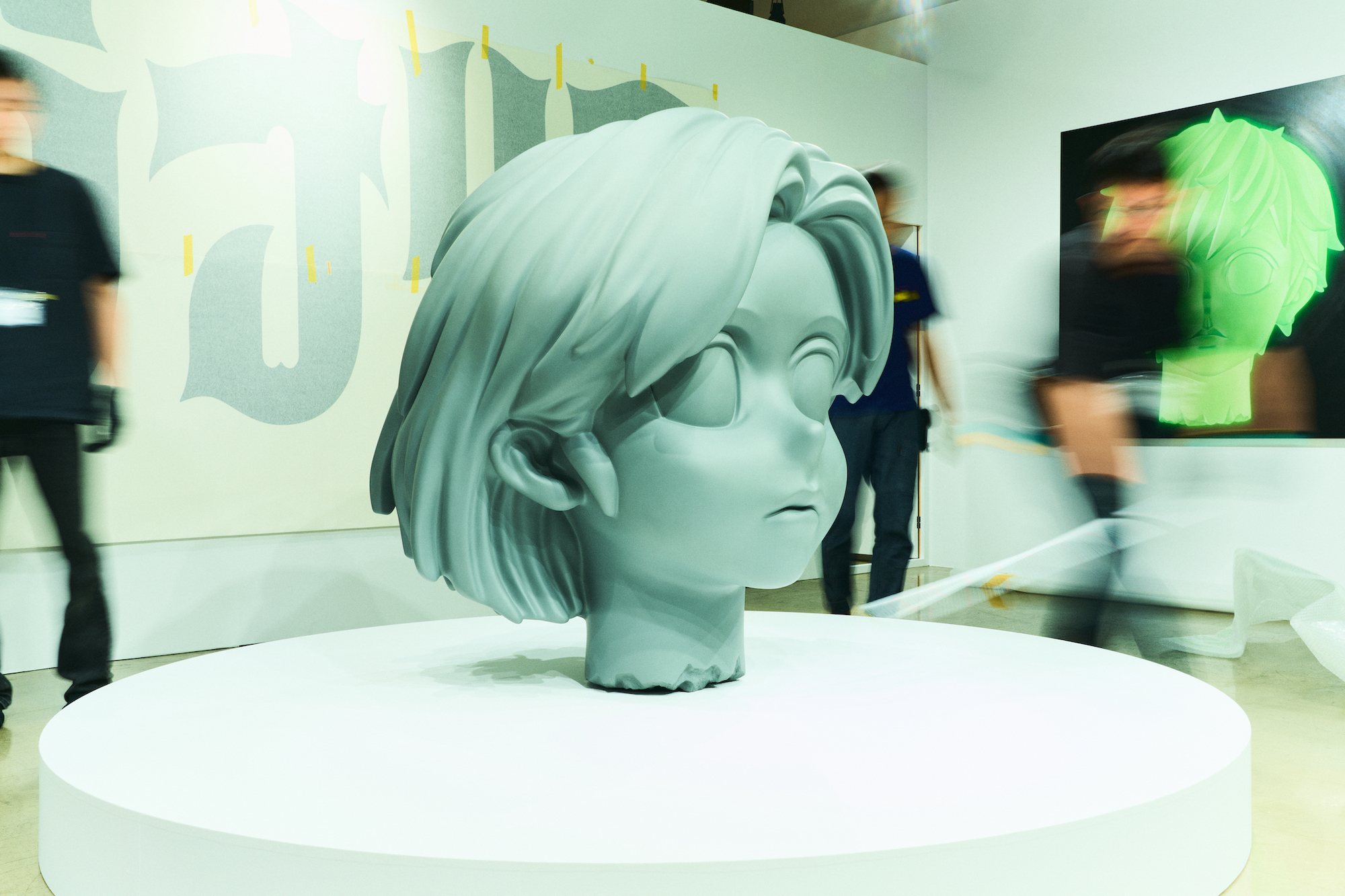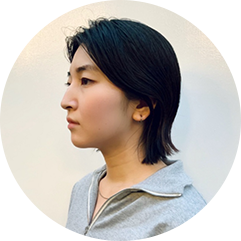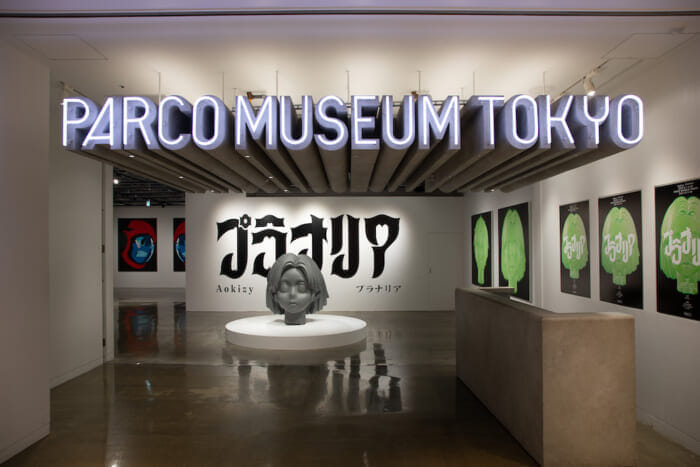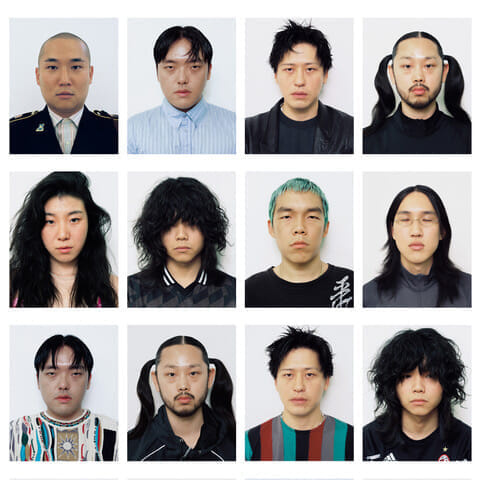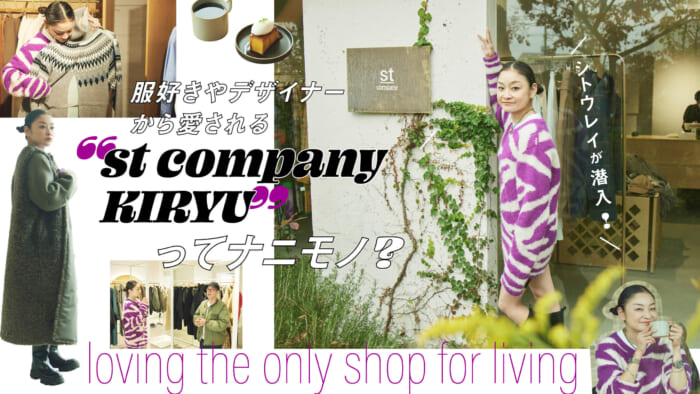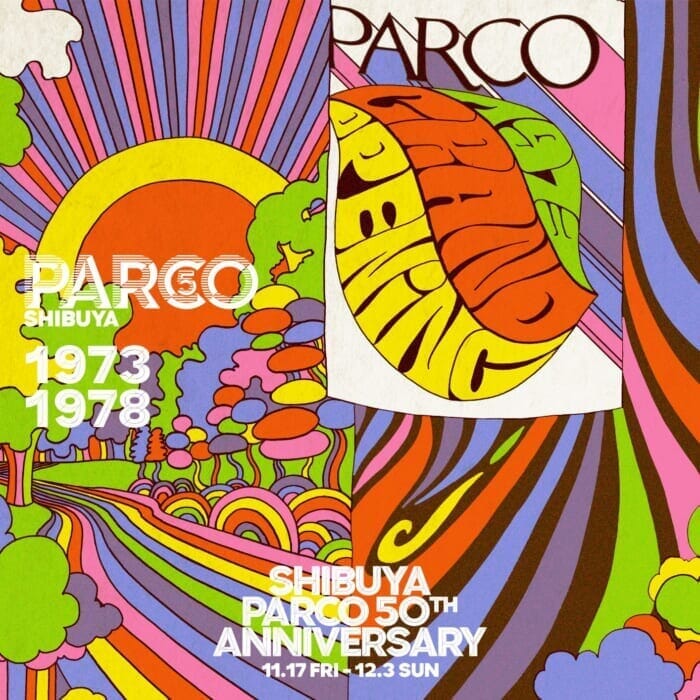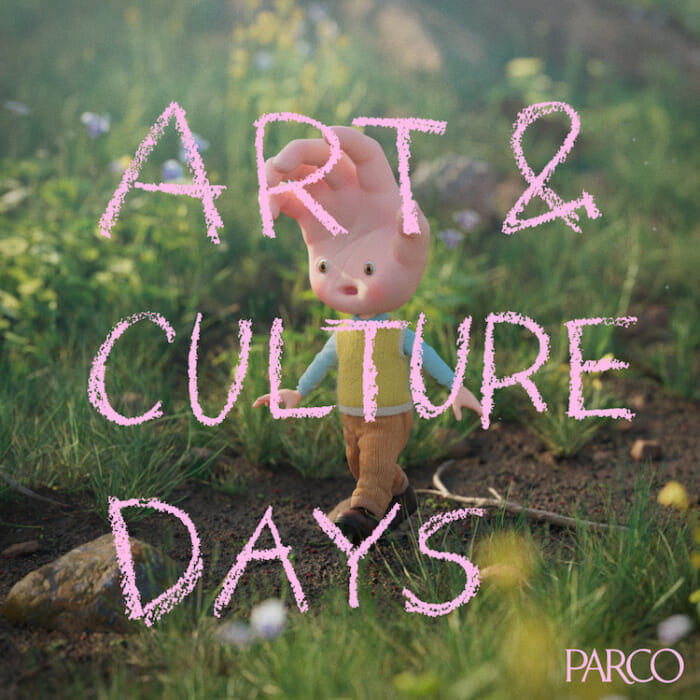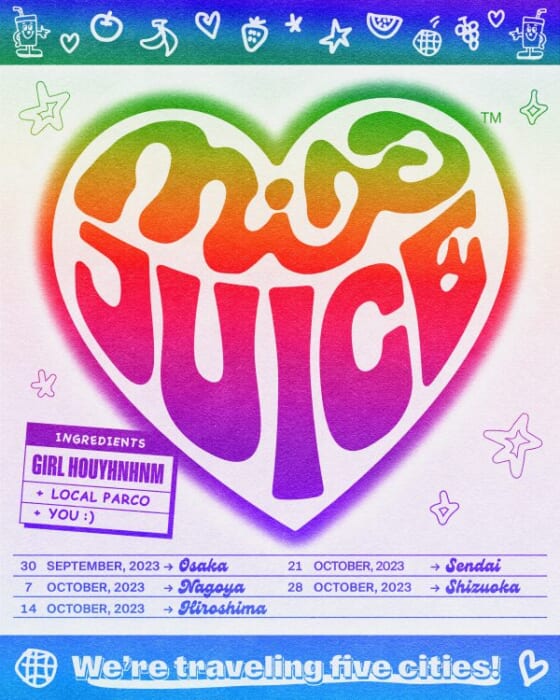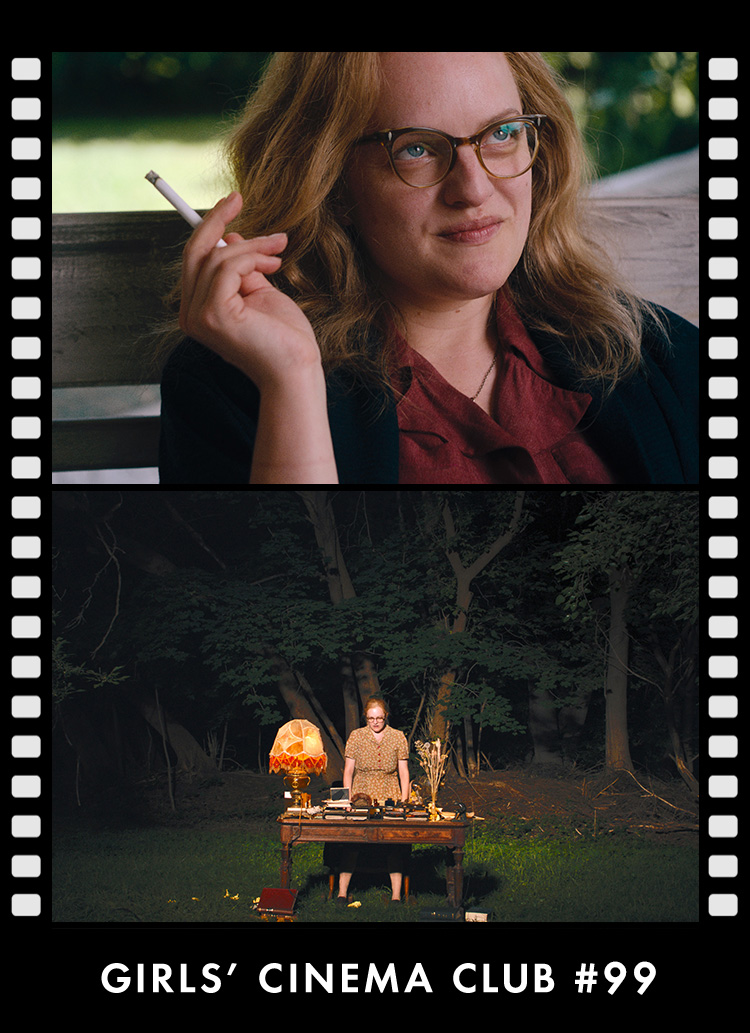AOKIZY is an artist based in Korea. Many of his works depict close-ups of human faces, and he has many fans both in Japan and abroad for his indistinguishable facial expressions and the unique appearance of his works. In his home country, AOKIZY is extremely popular as an up-and-coming artist in the art world, and he has also created jackets for Korean hip-hop artists and bands. We conducted an e-mail interview with AOKIZY in HOUYHNHNM on the occasion of his first solo exhibition in Japan. Please take a look at the photos taken at the time of setting up the exhibition two days before the opening. (For details of the exhibition, please seeNews article here(from)
Photo_Kohei Kawatani
Edit_Yuri Sudo
Questioning originality.
The evolution of digital devices has resulted in the mass creation and dissemination of images. Everything is created and passed on again and again, and at such a tremendous pace that users are no longer enjoying but rather consuming the images. Moreover, images have been copied, homaged, parodied, and reworked one after another, obscuring the true source of the images.
AOKIZY is an artist who questions originality while keeping an eye on such trends of the times. His motifs and expression without concreteness have the power to make viewers stop and think. While AOKIZY's work has not yet been widely covered in Japan, and even the web media has not yet published information on his work in Japanese, PARCO has taken the opportunity to offer a solo exhibition of his work.
In this interview, we asked him about his method of production, his own ideas, the Korean art scene, and his vision for the future. We are sure that this interview will help you to think about your artwork. Below is the full text of the e-mail interview.
Margins of ambiguity.
First of all, please tell us what kind of childhood you had and how you decided to become an artist.
Ever since I was a child, I have loved collecting music CDs, DVDs, and manga. Nowadays, technology is so advanced that we can easily obtain all the content, but that is why I want to "own" the things I like even more. I think becoming an artist is one manifestation of my desire for ownership, and I want to create what I want and what I want to see myself.
Incidentally, in an interview with a Korean magazine, you said that you were influenced by Japanese anime.
I first became interested in manga at the end of 2009, when the iPhone was first released in Korea. At the time, I started reading Korean manga (webtoons) on my iPhone. It was very refreshing to see digital manga ported to the web and mobile environment, and that too through the latest digital device, a smartphone. After that, I started digging Japanese manga.
What exactly do you like about Japanese manga?
What attracted me to Japanese manga is the development of extreme settings and styles. To elaborate, the lines and shading in manga are an incredible compression of information. The way the face is represented in Japanese manga is unique, and I believe it further compresses the result of that compression once again as a reference. In other words, I believe that manga is an art form that was conceived and developed as something that can be easily drawn by anyone, regardless of individual talent, and is a very planned and industrial art form that ensures efficient production and collaboration among its creators.
What are some of your other influences?
Among Japanese artists, I greatly admire the work of Mr. Go Nagai and have been influenced by him in many ways. Sometimes I compare Mr. Nagai to the Western artist Caravaggio. Just as the relationship between Caravaggio and the art world of his time, I feel that Nagai's work is completely different from the mainstream of the Japanese manga world and the Disney style, creating shocking works that show cruelty and violence through intense composition and color.
I have the impression that many of your works focus on people's faces.
It is true that I often use extreme close-ups of faces as motifs in my works. My intention is to immerse the viewer in the work and encourage individual interpretation by completely eliminating all information about the body except for the background and the face in the close-up.
In close-ups, facial features are also important in creating the atmosphere of the work, but I felt that AOKIZY dared to be vague about the specifics of these features.
I do not assign status, culture, gender, or time period to any of my characters. When someone talks about my painted characters, they often refer to them in terms of gender (male/female, etc.), but I myself do not use such distinctions, not only in the motifs of my works, but also in my colleagues, gallery staff, and others. At most, I only distinguish between "long hair" and "short hair. Sometimes I give titles that leave no room at all for the viewer to think that the characters are human. We want the viewer to be free to interpret them as they see fit.
The faces themselves are not concrete, but the facial expressions seem to capture a specific moment. Do you have some kind of setting or storyline in mind when you draw them?
Initially, I concentrated on painting deliberately intense facial expressions in order to give a fresh look to the familiar theme of portraiture. They are angry or tragic expressions, as in the final phase of a battle or race. However, I realized at one point that the audience who saw my work accepted it differently than I intended, just as the audience who watches a movie gives a different point of view than the director intended. So recently I have been trying to use more ambiguous facial expressions, for example, I sometimes refer to the facial expressions of traditional Korean Buddhist statues.
Compared to when you first started as an artist, has your attitude and style of work changed?
At first I concentrated on creating a single image from a variety of sources. Sometimes I worked deliberately so that I could guess what kind of things I was sampling. Nowadays, I sometimes create new iconography based on the images I have created. A kind of self-sampling, so to speak. This is the biggest change. Gradually, what the earliest sampling was like has become vague.
I heard that in addition to creating artworks, you also work on advertising projects such as cover album productions for artists.
In advertising projects, I have to work with the client to find compromises, which is a big difference from individual work. However, there are times when results are produced that neither I nor the client expected, and this can be a hint for the next production. So I try to think positively when I receive requests for advertising projects.
Please tell us a little bit about what you do after you create a work. Looking at your Instagram page, I get the impression that you intentionally take pictures of your works as they are being installed at the exhibition site. Are you interested in what happens to your works after they leave your hands?
As you say, I am interested in how it will actually be installed and displayed. I don't know if my work is real or digital data unless I tell you, so that may be another reason why I am interested in it. I am also interested in seeing how they will be used not only in regular offline exhibitions, but also on a scale such as online, or even in offline spaces without materiality.
What is even more interesting is that some users consume my artwork as profile images on social networking sites or as interior accessories. More interestingly, I also find it interesting that they almost equate my work with commemorative goods.
Japanese manga culture again.
In this exhibition, "Planaria," we were able to see works in various forms, such as two-dimensional, three-dimensional, and video, and it seemed like you were experimenting with the same motifs and which form to use for output. How did you come to use various techniques?
The first two-dimensional paintings I created were beautiful works, mainly utilizing masking tape. Derived from these two-dimensional works, I used relief (a method of sculpture in which the sculpture is fleshed out so that it rises from the two-dimensional work), and for three-dimensional works, I created 3D images using white plaster figures and metal. Gradually, the surfaces of the three-dimensional works became rougher and more like weathered stone, and the individual media evolved from small to large in size.
Recently, I have been concentrating on the flat surface again, but the atmosphere has become more like a 2.5 dimensional one, mixing the attempts I have made in the past with three-dimensional and video.
Looking at your past works, I felt that many of them used the same motifs in multiple lines. I felt that the theme of this year's exhibition, "Planaria," further clarified the style of your work.
We believe that contemporary image culture is not simply the mindless consumption of mass-replicated images, but that many people are partially reproducing images based on their initial exposure to them. The titles we have given to the exhibition so far, such as "UN ORIGINAL" and "JPEG SUPPLY," describe this period of circulation and indiscrimination in a nutshell, but "Planaria" is more metaphorical and holistic.
As invertebrates, planaria divide and reproduce in the same form, but in fact all are recognized as new, independent individuals. Parents and offspring are not clearly separated, and it can be said that partial originals exist and none of them are actually real. I thought this title was more effective at this time, when we are actively promoting international exhibitions.
I heard that you have exhibited in London, China, Spain, and other countries in addition to Korea. Have there been any differences in the reactions of the audiences in those countries? Also, what do you expect from the opening of your work to Japanese audiences this time?
Of the overseas exhibitions, the UK and China were held during the Corona period, so we were not able to get a good sense of audience response. So, in effect, this time in Japan is the first exhibition where we can learn about the reactions overseas.
My drawings are formally similar to Japanese manga. The influence of Japanese manga and culture is an integral part of Korean history. Korea began importing Japanese manga in earnest in 1998, and I came into contact with manga a decade later than that. I could not tell whether the manga I liked were Japanese or Korean. I remember there was a mixture of originals and reproductions. Therefore, I consider myself more of an artifact of my own self-assembly by absorbing the essence of various visual cultures, regardless of nationality, form, or content, than of the manga itself. I hope you can get a sense of how the manga form familiar to the Japanese people was reborn through this complex context. I am also curious about your reaction when an image that you have only come into contact with online actually appears in front of you with materiality.
Lastly, AOKIZY, what is your view of the current Korean art scene? And in such an industry, what kind of artist do you want to be in the future?
Looking at the current Korean art scene, an important event is the emergence of a new consumer group. The main consumer group, Koreans in their 50s-60s, are the generation that actively imported and watched Japanese manga, anime, and Hollywood movies. Younger consumers are very active in visual culture through the Internet and smartphones. Although the generations are different, they all create collections of their personal tastes, and their tastes are clear. I think this is also the reason why my images are consumed by different generations in Korea at the same time.
I always try to depict the "present" within the flow of my perception, and I want to be an artist who will be remembered in the future as "present" and not as something from the past. I want to be an artist who will be remembered as "present" and not as something from the past in the future.
AOKIZY "Planaria
Venue: Shibuya PARCO 4F, PARCO MUSEUM TOKYO
Period: Friday, June 7, 2024 - Monday, June 24, 2024
Business hours: 11:00 - 21:00
*Admission until 30 minutes before closing.
*Close at 6:00 p.m. on the last day.
Admission: Free
Exhibition Special Page
PARCO ART Official Instagram
AOKIZY Official Instagram







